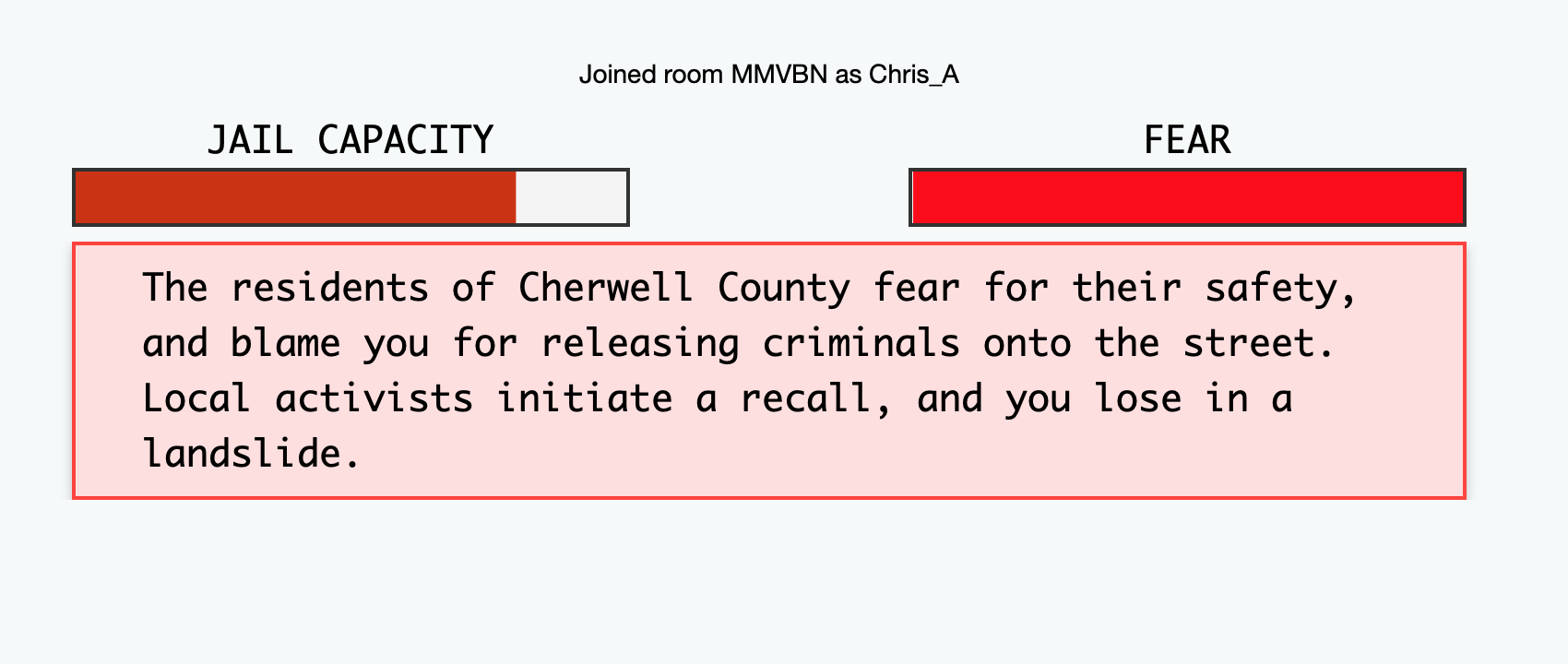Detain/Release
In Vogt’s. (n.d.-b) The Crime Machine, Part II the line “it was like the crime rate itself became the boss” is uttered and while completing the Detain/Release task this felt very true. The crime rate indicator being the fear bar in this case.

As I engaged with the task and gave a verdict on each case I noticed that the colour coding of the factors was significant to me and generally easy to understand. It commanded my attention in a way plain text alone did not. The design of the interface was certainly designed to lead my attention to some information over others. This would certainly show creator bias. The blurring out of the photos was not really helpful if the intention was to remove racial bias as the skin tone showed in the photos. The person’s name would also reveal information such as gender and possibly ethnicity. But this may not have mattered if the bias against marginalized communities was already built into the data set that the AI creates its suggestions from. This parallels Vogt’s. (n.d.-b) concern in The Crime Machine, Part II when he notes that CompStat “was this intensely broken version of the kind of policing Jack had pushed for [as] you weren’t actually targeting the people committing crimes, you were just targeting the people who were the same race and age.” In the same way that marginalized communities can be born into generational poverty they can also be affected by AI (such as CompStat) which places attention on where the data says crime occurred which in itself carries the bias of the original data by the arresting officers acknowledged or not. Knowing this I tried to pay attention to the crime committed and the level of violence most. If the crime was not violent I was encouraged more to release the person even if the “Fail to appear” or “Commit a crime” was rated medium or even high for either or both. The statement of the defendant was the section I read and considered last if I was unsure what decision to make.
The wording leading into the activity was heavily biased and framed the context for this activity. The system made you very aware you were accountable to the public and the newspaper would be your friend or foe. This was proven by the newspaper’s wording in the articles which shows bias by using wording such as “it is unclear why” I made the decisions I did. There was no balanced reporting as there was no mention of constraining decision factors such as jail capacity.
I felt that the rise in jail capacity increments after each verdict was not equal to the rise in fear increments when a news article appeared. I also did not know when fear would rise as the newsflashes arose seemingly at random. As such the progress bars became very present and almost gamified this experience. It led me to believe I was up against a clock and encouraged me to make decisions faster than I would have liked to. I also could not see which case number I was on and without this information, I could not balance my decisions based on the remaining white space in the program bars. Meaning that as the bars filled up I was aware of rising jail capacity and fear more than I was the details of the cases themselves. This would of course bring up ethical and moral issues if these were indeed real cases.
I did not always follow the advice of the AI. I believe I never detained a person who was recommended for release and if that is true I do not think I would be able to balance the jail capacity and fear. But maybe I am wrong on this as I have seen evidence that other people were successful in this process and were not recalled. As there was no review or summary of the decisions I made on the final screen so I could not confirm.
In The Crime Machine, Part II, Vogt (n.d.-b) notes that the crime statistics being collected “don’t even measure how safe the people in a community feel.” This was interesting to me as the Detain/Release activity attempts to quantify this but through biased news reporting and the reciprocal fear it generates in Charwell County. However, there is no real indication of how this fear is measured and if this fear is perceived or real and by whom. The indicated and justifying result of fear is the landslide recall of my position by activists whom I know nothing about, be it race, gender, affluence or political leanings. Even if I could have eked out a balance of the bars without filling one, both would be quite full. There does not appear to be a utopian outcome but only one where AI might be able to help keep jail capacity and fear just barely under a set threshold
Works Cited
Vogt, P. (n.d.-b). The Crime Machine, Part II. In Reply All.

Hi Chris,
I think your last point about how problematic the attempt to quantify fear is a really good one. Not something I initially picked up on when doing the activity. You have given more to think about it. Thanks.